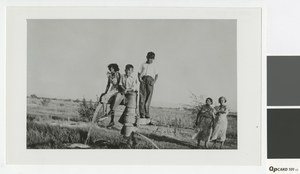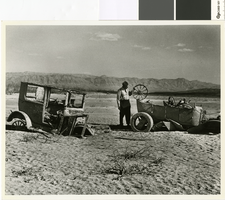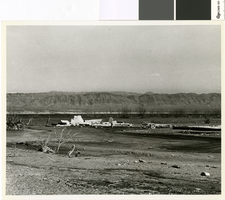Search the Special Collections and Archives Portal
Search Results

Photograph of children gathered by an artesian well near Tule Springs, circa 1938
Date
Archival Collection
Description
(left to right) Celia Rivero, Johnny Weber and Alfonso Rivero gathered by a well near Tule Springs with Margarita Rivero and Maria Weber looking on.
Transcribed Notes: 'Attached sheet: Las Vegas Review-Journal, The Nevadan, 'Help Us Write History,' February 7, 1982 -- Source: Celia Munney, 870-0713, 6301 Garwood. Born 1926. l-r: 1. Celia Rivero, 2. Johnny Weber, 3. Alfonso Rivero, cousin, 4. Margarita Rivero, mother. Died 1974, 5. Maria (Chuey) Weber, aunt. Deceased. ca. 1938. Picture taken near Tule Springs. Had restaurant, Frank's Cafe, on First St. near Fremont (pres. parking for California Club). Frank Rivero had 3 restaurants: 1 behind present Mint; 2nd near Home Lumber site; and this one. Frank died in 1948. Had Mexican and American food. Made lunches for Boulder Dam crews. Has pictures and made appointment to see her 2-17-82, 3:30 pm. Elko Rooms next to Frank's Restaurant owned by an aunt you came to LV in 1917.'
Image

Photograph of two cars abandoned by their owners in St. Thomas, Nevada, April 11, 1948
Date
Archival Collection
Description
Remains of two cars, most likely near the remains of Hugh Lord's shop, in St Thomas, Nevada, when the town emerged from the waters of Lake Mead in 1945
Transcribed Notes: Bureau of Reclamation typed notes appended to back of photo: Boulder Canyon Project--Nevada--Region 3 St. Thomas, Nevada, was founded by the Mormons in 1855. In its heyday there were about 800 residents in the village. The "Main Street" was a part of the old Arrowhead Trail, which led from Salt Lake City, Utah to Los Angeles, California. In June 1938 the town was abandoned by its residents, which at that time were few in number because of the rising waters of Lake Mead that submerged the townsite. Photograph shows a closeup of two cars abandoned by their owners. Note the wide wooden wheel on the car to the right; also, the smaller wheel with wooden spokes. The wide wooden wheel was used as an "engine" to pump water, the belt being placed on this wooden wheel.
Image

Photograph looking southeast through the remains of the post office in St. Thomas, Nevada, 1948
Date
Archival Collection
Description
The remains of the St. Thomas post office and Harry Gentry's store with Lake Mead in the background
Transcribed Notes: Bureau of Reclamation typed notes appended to back of photo: Boulder Canyon Project--Nevada--Region 3 St. Thomas, Nevada, was founded by the Mormons in 1855. In its heyday there were about 800 residents in the village. The "Main Street" was a part of the old Arrowhead Trail, which led from Salt Lake City, Utah to Los Angeles, California. In June 1938 the town was abandoned by its residents, which at that time were few in number because of the rising waters of Lake Mead that submerged the townsite. In 1945, after having been flooded for 7 years, receding waters of Lake Mead revealed St. Thomas much as it has appeared in former years. This photo was taken looking toward Mormon Mesa. The receding waters of the lake can be seen in the center of the photo.
Image

Breakdown of costs of water for the Union Pacific Railroad and the Las Vegas Land and Water Co. in 1934, February 15, 1935
Date
Archival Collection
Description
Breakdown of costs of water for the Union Pacific Railroad and the Las Vegas Land and Water Co. in 1934.
Text

Letter from A. M. Folger (Las Vegas) to R. L. Adamson, September 13, 1950
Date
Archival Collection
Description
Folger recommends installing a remote pressure gauge in the pipeline away from the pumps, because when leaks develop the pressure does not drop at the pumps, making it harder to realize there is a problem
Text

Letter from T. E. Fennessy (Las Vegas) to the Las Vegas Land and Water Company, May 31, 1946
Date
Archival Collection
Description
Letter written by the Las Vegas City Manager, announcing a meeting on June 14, 1946 to discuss the water situation in the Las Vegas Valley. The letterhead includes a green colored engraving of an artesian well and an irrigation headgate. The attached letter mentioned by Mr. Fennessy is referenced below.
Text

Letter from Walter R. Bracken to Charles McCall (Las Vegas), May 17, 1945
Date
Archival Collection
Description
Bracken asking the city manager to require the more intelligent use of water in the Huntridge Addition city park to set a good example for residents.
Text

Letter from Frank Strong (Los Angeles) to E. E. Bennett, May 5, 1945
Date
Archival Collection
Description
Strong believed that the water company's protest against Griffith's well was ill-conceived and recommended selling water at wholesale rates to Griffith.
Text

Letter from Walter R. Bracken (Las Vegas) to W. M. Jeffers, November 13, 1944
Date
Archival Collection
Description
The Chamber of Commerce agreed that the artesian water in the valley should be reserved for domestic purposes, and Lake Mead water for irrigation, but Bracken wrote that this was academic because Basic Magnesium Inc. had no excess water.
Text

Memo from H. H. Larson to Union Pacific Railroad Company employees about water conservation, February 13, 1942
Date
Archival Collection
Description
Notice to all railroad employees of the importance of conserving water as much as possible.
Text
